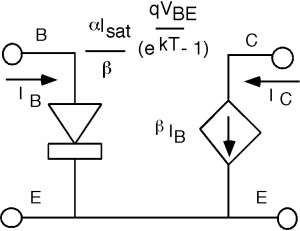3.5.4: Common Emitter Models
- Page ID
- 89964
Let's go ahead and draw a model for the transistor in the common emitter configuration (Figure \(\PageIndex{1}\)). We again have a diode connected between the base and the emitter, and a new current controlled current source between collector and emitter. There is one small caveat which we need to keep in mind, however, when drawing the common emitter circuit. The diode we see in the base circuit is not the same one as we had in the common base model. In the common base model, it was true that \[I_{E} = I_{\text{sat}} \left(e^{\frac{q V_{\text{BE}}}{kT}} - 1 \right) \nonumber \]

For the base, however, only a small fraction of the current that goes through this "diode" actually goes in through the base, the rest is coming in through the collector. Thus we have to make a couple of changes. \[\begin{array}{l} I_{C} &= \alpha I_{E} \\ &= \alpha I_{\text{sat}} \left( e^{\frac{q V_{\text{BE}}}{kT}} - 1 \right) \end{array} \nonumber \]
\[\begin{array}{l} I_{B} &= \frac{I_{C}}{\beta} \\ &= \frac{\alpha I_{\text{sat}}}{\beta} \left( e^{\frac{q V_{\text{BE}}}{kT}} - 1 \right) \end{array} \nonumber \]
So the operational equation for the diode in the base circuit still is the usual exponential function of \(V_{\text{BE}}\), except that it now has a saturation current of \(\frac{\alpha I_{\text{sat}}}{\beta}\) instead of just \(I_{\text{sat}}\).
In principle you could put this model into a circuit, and analyze it to find all of the necessary voltages and currents. However, this would not be very convenient. The base-emitter junction is connected by a diode, which as we know, has a very nonlinear \(I \text{-} V\) relationship. It would be nice if we could come up with a linear model which, at least over some limited range of inputs, we could use with confidence.


